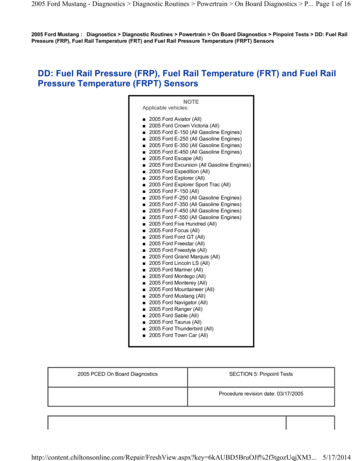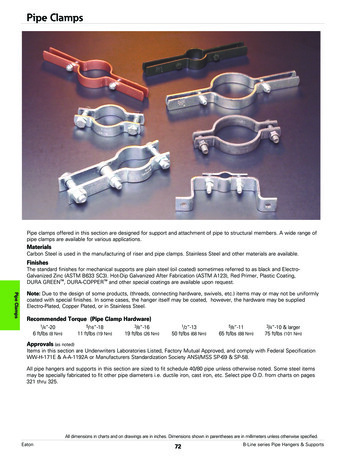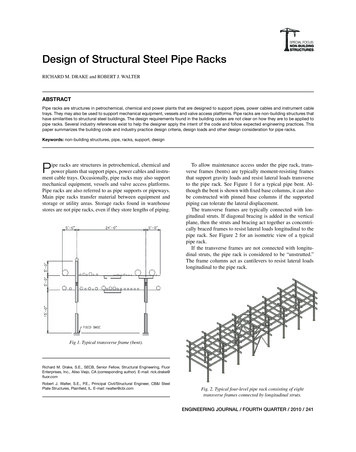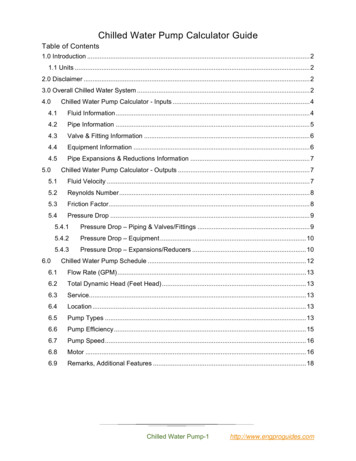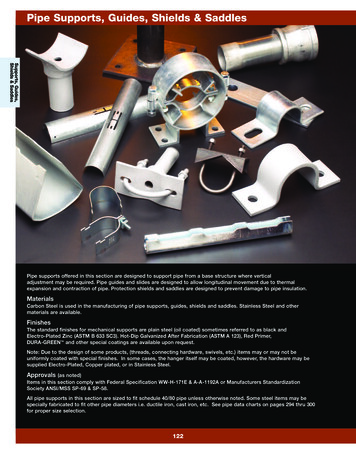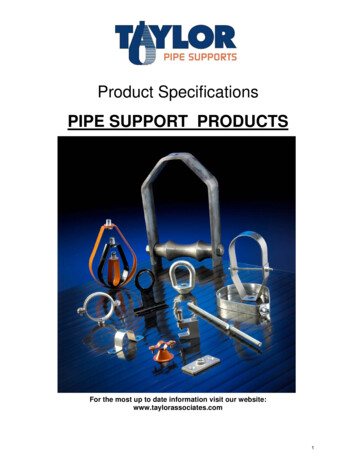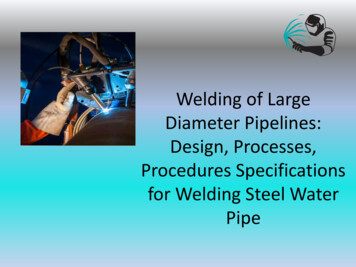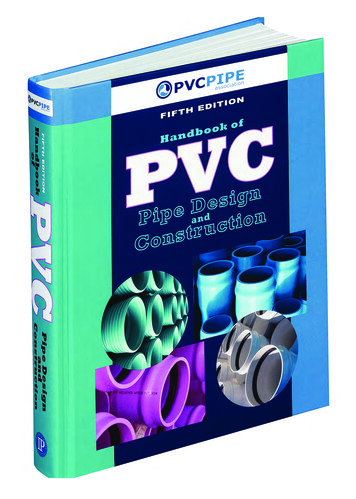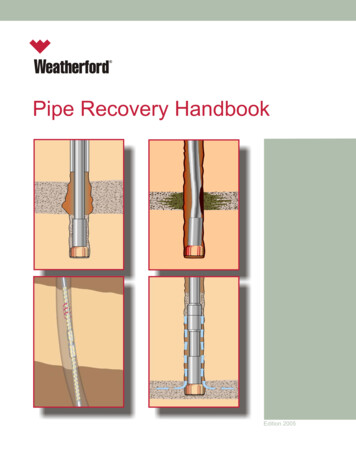
Transcription
Pipe Recovery HandbookEdition 2005
ContentsList of Tables .4Introduction.5Wireline Pipe Recovery Overview .6Well Configuration and Conditions .7Types of Sticking .8Sand Sticking. 10Mud Sticking . 11Mechanical Sticking . 12Differential Sticking . 13Key-Seat Sticking . 14Undergauge Holes. 15Sloughing Holes . 16Blowout Sticking . 17Cement Sticking . 18Lost Circulation. 19Free-Point Services . 20Logging Services . 24Backing Off . 26Cutting the Pipe . 32Chemical Cutter. 33Jet Cutter . 34Radial Cutting Torch . 35Split Shot . 36Severing Tool. 37Mechanical Cutter. 38Pipe Recovery Handbook, 1st ed. July 2005.The products in this catalog may be covered by one or more United States and/or international patents. Please address all inquiriesconcerning intellectual property to:Weatherford International Ltd.Legal Department515 Post Oak Blvd., Suite 600Houston, Texas 77027 USATel: 1-713-693-40003 2005 Weatherford. All rights reserved.
List of TablesTable 1—Weatherford’s Process for Estimating Free Point . 22Table 2—Buoyancy Factors. 23Table 3—Overpull Weights . 23Table 4—Tightening Torque. 26Table 5—Reverse Torque . 26Table 6—String-Shot Strength for Tubing. 28Table 7—String-Shot Strength for Drillpipe. 29Table 8—String-Shot Strength for Drill Collars . 30Table 9—String-Shot Strength for Casing and Washpipe . 31 2005 Weatherford. All rights reserved.4
IntroductionNo two sticking situations are alike. Myriad wellconfigurations, well conditions and types of stickingmean that each pipe recovery operation is unique. Allsticking situations, however, have two factors incommon: stuck pipe is always an unanticipatedproblem; and freeing stuck pipe is always an urgentrequirement.Successful pipe recovery operations depend onexperienced crews. Experienced crews blendknowledge and technology to analyze specific wellconfigurations and conditions, identify the cause ofsticking, determine the free point, recover the pipe, andleave the fishing crew with a retrievable fish.Technology advances bring new techniques while enhancing the old to speed the recovery of production.5 2005 Weatherford. All rights reserved.
Wireline Pipe Recovery OverviewThough each job is unique, a good operatorunderstands the value of using a standard process toapproach each situation.The following flowchart illustrates Weatherford'srecommended process for pipe recovery.Analyze the well configuration and well conditions at the time of sticking.Gather and analyze information about current well conditions.Gamma ray, pipe recovery, and noise/temperature logs might provideadditional relevant information.Work the pipe and determine the estimated free point.Run a free-point tool to determine the uppermost stuck point.A pipe recovery log can be used to identify the amount of stuck pipebelow the uppermost stuck point.Select the best method and tools to separate the pipe.Back off, cut or sever the pipe.Remove the free portion of the pipe from the well. 2005 Weatherford. All rights reserved.6
Well Configuration and ConditionsWell ConfigurationWell configuration and well conditions affect both whythe pipe is stuck and how it will be freed. The easiestway to visualize the many elements of the well is tomake an annotated sketch of the well at the start of thejob, before beginning pipe recovery operations. A goodwell sketch facilitates communication between thecustomer, fishing personnel, and the Weatherford piperecovery specialist. It should includeWell ConditionsPipe recovery operations may be complicated bycertain challenging well conditions, including! shallow straight holes;! deep straight holes;! directional (deviated) holes;! high temperatures;! high pressures;! multiple tubing strings;! mixed strings.! total depth of well and hole size;! all casing sizes and weights;! string configuration including pipe sizes, depth,weight, and when necessary bottomhole assembly;! hole angle and any kickoff points;! composition and weight of the wellbore fluid;! bottomhole temperature (BHT);! surface pressure;! bottomhole pressure (BHP);! cause of sticking, when known;! record of previous pipe recovery attempts.7 2005 Weatherford. All rights reserved.
Types of StickingMudSandMechanicalDifferential 2005 Weatherford. All rights reserved.Key-Seat8
Types of StickingSloughing HolesUndergauge HolesBlowoutCementLost Circulation9 2005 Weatherford. All rights reserved.
Types of StickingSand StickingClassic sand sticking occurs with tubing in a casedhole. A leaking packer or a hole in the tubing or casingcan allow sand to enter the annulus. Over time, sandcan accumulate to a level that prevents the string frombeing pulled.Identification! Is there a history of sand production at the surface?Free-Point TendenciesFree-point operations in sand-stuck pipe can bechallenging. As the pipe is worked, small pockets, orvoids, may develop at the tubing collars. These voidsallow just enough movement for the free-point tool toindicate free pipe at points below the level where thepipe can possibly be retrieved after a backoff or cut.HoleUsing higher working weights when determining thefree point helps to obtain an accurate backoff or cuttingdepth.Stretch readings in sand-stuck pipe are often erratic.Torque readings can generally be taken at deeperdepths than stretch readings, and are usuallyrepeatable. Take both stretch and torque readings sothat there is a point of comparison when determiningthe free point.Techniques for Freeing the PipeWhen picking a backoff or cut depth in sand-stuckpipe, choose a point at some distance uphole from thestuck point, where the pipe is 100 percent free. Afterthe pipe is backed off, the remaining fish should bewashed over to remove all remaining sand from theannulus. Pipe recovery operations can then continue. 2005 Weatherford. All rights reserved.Hole in Tubing Allowing Sand to EnterAnnulus10
Types of StickingMud StickingMud sticking is typically encountered in cased holes, but itcan also occur in openhole environments.Mud sticking commonly occurs when trying to retrievetubing on a recompletion job. Wells are often completedwith mud behind the tubing above the packer. Over time,weighting materials in the drilling mud (particularly barite)may settle and collect on top of the packer. The weightingmaterials can harden and stick the pipe. Hightemperatures can accelerate the process.In open holes, contaminants such as shale, soluble saltsand acidic gases can mix with the mud, dehydrating it andcausing the pipe to stick. Contaminants can have thesame effect in cased holes when there is a hole or leak inthe casing or tubing.Identification! What type of fluid is in the annulus?! How long has the fluid been in the hole?! When was the last time the mud was circulated?Free-Point TendenciesThe pipe should be worked thoroughly to free as muchpipe as possible before running the free-point indicator.Working down below the weight of the string usually freesthe pipe more effectively than pulling strictly above theweight of the string.Continuous working of the pipe may create small pocketsor voids around the tubing collars or tool joints. The voidsallow just enough movement for the free-point tool toindicate free pipe at points below the level where the pipecan possibly be retrieved after a backoff or cut.Mud Sticking in Cased HoleUsing higher working weights when determining the freepoint helps to obtain an accurate backoff or cutting depth.Techniques for Freeing the PipePerforations can be used in open holes to break up themud and encourage circulation. In cased holes where thefluid in the annulus is in a liquid or semi-liquid state to thepacker, perforating the tubing above the packer mayestablish circulation and allow the assembly to be pulledfrom the hole.11 2005 Weatherford. All rights reserved.
Types of StickingMechanical StickingMechanical sticking typically occursin cased holes, but it may alsooccur in openhole environments.Types of mechanical stickinginclude:!!!!!collapsed casingbent pipestuck packersjunk in the holewrap-around tubingCollapsed CasingBent PipeCasing may collapse because ofwell pressures or for other reasons,causing the tubing to stick.Sticking may also occur when thepipe is bent. Bent pipe is usually aresult of dropping the pipe.Stuck PackersJunkWrap-Around TubingWhen the release mechanism on aretrievable packer fails, the packeris stuck, preventing the tubing frombeing pulled. With permanentpackers, corrosion can formbetween the tubing and the packer,preventing the tubing from beingpulled.Sticking may occur when a foreignobject (for example, a wrench,tong, or hammer) falls into the holeor a piece of the tool string breaksoff in the hole. The junk can wedgenext to the pipe string and causethe pipe to stick.Wrap-around sticking can occurwhen multiple strings of tubing arerun separately instead of in dualmode, causing the tubing strings totwist and wrap around each otheras they are run in the hole. 2005 Weatherford. All rights reserved.12
Types of StickingIdentification! Is the hydrostatic pressure of the mud column in the!!!!!wellbore greater than the formation pressureopposite the stuck pipe interval?Is the formation opposite the stuck point porous andpermeable, possibly sandstone?Was the pipe stationary for several minutes oppositea porous and permeable zone (for example, whilemaking a connection), allowing a fairly large area ofthe pipe to come into contact with the formation?Is it impossible to pull or rotate the pipe? Can thewell fluid be circulated at normal pressures andrates?Is the hole clean and in good condition?Is the wellbore fluid clean and in good condition?Free-Point TendenciesFree-point readings can help to identify differentialsticking. When sticking is confined to a single interval,free-point readings will drop off over a very shortdistance. If there are several stuck intervalscontributing to the overall sticking, free-point readingswill drop off over a longer distance. A gamma ray logcan determine whether the formation has numerousporous and permeable zones.Differential Sticking, AlsoKnown as “Well Sticking”Mud logs and temperature logs can also provideinformation that may help to pinpoint the cause ofsticking and identify the best means of pipe recovery.Differential StickingDifferential sticking, also called wall sticking, is acommon cause of stuck pipe in open holes. Differentialsticking occurs when the hydrostatic pressure exertedby the mud column in the wellbore is greater than theformation pressure. The pressure differential (in otherwords, suction) causes the drill string to stick to thewellbore. The pressure differential can also create fluidloss to a porous and permeable formation. Over time, amud-cake buildup can reinforce the sticking.Techniques for Freeing the PipeRotating or applying downward movement to the pipeis more likely to break the mud seal than pulling on thepipe.Lowering the mud weight may also free a differentiallystuck string. However, the mud weight should not bereduced if well control is a problem. Jarring operationscan also be conducted to try to free the pipe.If the pipe needs to be backed off or cut, free-pointreadings must be taken to establish the point at whichthe pipe is completely free. When dealing withdifferentially stuck pipe, it is essential to leave sufficientpipe exposed, both to act as a guide for fishing toolsand to ensure a good reconnection. A backoff or cutclose to a casing shoe or in a washed-out area ordogleg may leave a fish top that cannot be re-engaged.ChallengesFreeing differentially stuck pipe can be difficult becauseof the strength of the hydraulic force holding the stringto the side of the wellbore. The hydraulic force may bea million pounds or more. Under such conditions, awashover might not free the pipe, a string shot mightnot result in a backoff, and jarring operations might beunsuccessful. Sticking can intensify with time;therefore, it is essential to act immediately to freedifferentially stuck pipe.13 2005 Weatherford. All rights reserved.
Types of StickingKey-Seat StickingKey seats are formed during drilling operations, whenweight is applied to the bit through the drill collars andthe drillpipe is normally in tension. If the hole isdeviated (in other words, if there is a dogleg),continuous rotation can slowly cut a groove into thehigh side of the dogleg, forming a key seat.The groove (key seat) is smaller than the mainborehole because it is not drilled by the bit, but worninto the formation by the smaller-diameter body of thedrillpipe. When the pipe is pulled from the hole, thelarger-OD stabilizers, drill collars and tool joints will notpass through the key seat.Identification! Did the driller encounter excessive drag at measuredtool joint intervals while pulling out of the hole?! Is the pipe free to rotate and circulate?! Is it possible to work the pipe up and down, but notpossible to move it up past a certain point?! Was the pipe moving upwards when it becamestuck?Free-Point TendenciesA free-point survey can help to identify key-seatsticking. To obtain stretch readings, the pipe must bepulled into the key seat and worked above the normalweight. If the pipe rotates freely, torque cannot beworked down to the stuck interval to obtain torquereadings.If the pipe has been pulled into the key seat tightlyenough to become completely stuck, the free-pointreadings will drop off over a short interval. A key seatmay be indicated if the pipe goes from completely freeto completely stuck near an OD change in the string.Key Seat in Deviated HoleTechniques for Freeing the PipeThe backoff point should be located several jointsabove the key seat so that the top of the fish is in themain borehole and out of the key seat. Fishing toolscan then be made up on the fish in the normal part ofthe hole. Coordination with the fishing tool supervisor iscritical when dealing with key seats. 2005 Weatherford. All rights reserved.14
Types of StickingUndergauge HolesSticking can occur in open holes where the diameter ofthe hole is smaller than the diameter of the pipe.Undergauge holes are caused by formation expansionor by abrasion on the bit and stabilizers.Using mud that has a lower hydrostatic pressure thanthe formation when drilling through shale with a high,expandable clay content can cause the shale to deformand the hole to close.Drilling through a salt section using oil-based mud cancreate an undergauge hole because the weight of theoverburden may cause the salt to flow into theborehole, shrinking the diameter.Drilling through an abrasive hole section can dull thebit and reduce the gauge (OD) of the bit andstabilizers. On subsequent trips with a new bottomholeassembly, the bit and stabilizers can become stuck.Identification! What was the diameter of the old bit and stabilizers?! Did the sticking occur when running a new, full-sizeFormation Expansionbottomhole assembly in the hole?! Were the drill string and new bottomhole assemblyrotated while tripping in the hole?Free-Point TendenciesStretch readings typically drop off over a short interval,usually near the bit. Torque readings also drop offsuddenly.Techniques for Freeing the PipeIf a full-gauge bit has become stuck while tripping in,jarring with an upward force will usually free the pipe. Ifthe bottomhole assembly is stuck below theundergauge hole, a backoff operation will benecessary. After a backoff, it may be possible to jar thefish out of the hole. If jarring is unsuccessful, awashover operation will enable the fish to be retrieved.Bit and Stabilizer Abrasion15 2005 Weatherford. All rights reserved.
Types of StickingSloughing HolesSloughing occurs when the wall of the wellbore isunstable. This unstable condition can cause the wall ofthe wellbore to collapse, or slough, into the drilled hole,trapping the drilling assembly in place.If improper hole conditions are present, any type offormation can slough into the wellbore and stick thedrilling assembly. A sloughing formation may occurwhen a shale sequence absorbs water from the drillingfluid. The water causes the shale to expand and fallinto the hole, sticking the drilling assembly.Sloughing is also caused by!!!!!!overpressured shale sections;steeply dipping shale beds;turbulent flow in the annulus;ledges that break off;surge pressures;accumulated particles in cavities.Identification! Before sticking occurred, were excessive amounts ofshale on the shakers at bottoms up?Did the driller encounter hole drag?Was there any fill on the most recent bit trip?Is circulation either greatly reduced or impossible?Were there variations in pump pressure beforesticking occurred?! Is it possible to rotate and pump fluid into theformation with no returns?!!!!Free-Point TendenciesThe pipe should be worked to free it as far as possiblebefore running the free-point survey. Continuousworking of the pipe may create small pockets, or voids,in the debris around the collars or tool joints. The voidsallow just enough movement for the free-point tool toindicate free pipe at points below the level where thepipe can possible be retrieved after a backoff.Sloughing Resulting from UnstableWellbore WallTechniques for Freeing the PipeA backoff operation is typically performed whensticking results from a sloughing hole. It is important toestablish a backoff point where the pipe is completelyfree. If the pipe is backed off at a depth at which itcannot be pulled, attempts to pull the pipe will lodgethe tool joints and collars above the pockets, making itdifficult, if not impossible, to engage the fish. 2005 Weatherford. All rights reserved.16
Types of StickingThe following conditions increase the likelihood of ablowout or pressure kick:! insufficient mud weight resulting from- efforts to free the pipe or avert differential stickingby lowering the mud weight- a lack of geological data about the field- formation liquids and/or gases entering the mudsystem and lowering the mud weight! failure to keep the hole full of fluid as a result ofimproper fluid measurement when tripping the pipe! pulling the pipe from the well too quickly when thehydrostatic pressure of the drilling mud is almostbalanced with the formation pressure, causing aswabbing, or piston, effectIdentification! Where is the casing set?! Has there been an unexpected increase in the mudtank volume?! Has there been a kick, or are there ongoing efforts tocontrol a kick?Free-Point TendenciesThe free-point tool typically registers clear movementin the free portions of the pipe and indicates a changefrom completely free to completely stuck over a fewfeet.Torque readings may show some movement in thestuck portion of the pipe; however, movement in thestuck area will rapidly decrease with depth.Techniques for Freeing the PipeBlowouts can result in more than onestruck point.When sticking occurs because of a blowout, there istypically more than one stuck interval. Free-pointsurveys alone are generally inadequate for determiningthe safest and most economical pipe recoveryprocedure because the free-point tool only defines theuppermost stuck section. Logging surveys used inconjunction with the free-point survey can provideuseful information for planning subsequent fishingoperations. A pipe recovery log can provide informationabout the sticking conditions below the uppermoststuck point. Noise/temperature logs can be used toidentify the source of the blowout and to verify whetherfluid movement is still occurring.Blowout StickingBlowout sticking occurs in open holes, and ischaracterized by sand, shale, and other formationdebris blowing uphole, bridging over, and sticking thepipe. The debris can also blow into another formation(an underground blowout). Pressurized fluid movementcan be to the surface or to a low-pressure formationdownhole. In these situations, there is often more thanone stuck interval.Blowouts typically occur when the formation pressureexceeds the hydrostatic pressure of the drilling fluid.17 2005 Weatherford. All rights reserved.
Types of StickingCement StickingCement sticking can occur in both open and casedholes and is usually a result of one of the following:! a mechanical malfunction (for example, a pump truckmalfunction or a leak in the pipe string)! miscalculation of displacement amount resulting fromhuman error or hole washout! efforts to contain a downhole blowout or preventexcessive lost circulation! human errorIdentification! Has cement been pumped into the well?! Did the cement job go as planned?Free-Point TendenciesStretch and torque readings will drop off over a shortinterval unless the cement has not had time to setcompletely.Techniques for Freeing the PipeA backoff or cut can be used to recover theuncemented portion of the pipe. Jarring operations willbe successful only if the cemented section is veryshort. If the pipe is centered in the hole, a washovercan be used to free the fish. If the pipe is not centered,it may be necessary to mill up the pipe and cement.When a very long interval of pipe is cemented,sidetracking or abandoning this portion of the well maybe the most economical solution.Cement-stuck points occur in openand cased holes. 2005 Weatherford. All rights reserved.18
Types of StickingLost CirculationLost circulation most commonly occurs when thehydrostatic pressure exerted by the drilling fluid cracksor fractures shallow, unconsolidated formations,allowing the drilling fluid to flow freely into theformation.The movement of the drilling fluid into the formationcan cause washouts, which can lead to sloughing holesticking.If the wellbore fluid has been weighted up to drillthrough a high-pressure zone and lost circulationoccurs, shallow gas can cause a blowout.Efforts to prevent lost circulation may cause cementsticking.Identification! Has there been a decrease in returns at the pit?Free-Point TendenciesFree-point tendencies are similar to those for sloughingholes, blowout sticking, and cement sticking,depending on the type of sticking that occurs as aresult of lost circulation.Techniques for Freeing the PipeRecovery operations are dictated by the type ofsticking that occurs as a result of lost circulation.Lost circulation leads to a variety ofsticking types.19 2005 Weatherford. All rights reserved.
Free-Point ServicesOverviewFree-Point SurveysThe free point is the deepest point at which the pipecan be recovered by a given method.A free-point survey can identify the uppermost stuckpoint in a pipe string and assess the severity of thesticking. The survey helps to determine whether toback off or make a cut, and it provides essentialinformation for selecting the correct tools to use duringthe pipe recovery operation. The survey cannot provideinformation about conditions below the uppermoststuck point. A pipe recovery log can give an indicationof sticking conditions below the stuck point to allowbetter planning of future operations.Most free-point tools are strain gauges. In other words,they measure the stretch or torque of the pipe betweena top anchor and a bottom anchor. Stuck pipe will notmove in response to applied stretch or torque.Because a free-point tool measures stretch or torque,and because stuck pipe will not move in response tosurface-applied stress, a free-point tool can determinewhether the pipe is stuck or free at a given point.To obtain an accurate free-point survey, it is importantto calibrate the free-point tool's sensor(s) to the freepoint panel before beginning the survey. Calibrating thetool in free pipe provides a baseline reading—a knownamount of stretch or torque in free pipe when stress isapplied to take a free-point reading. The baselinereading serves as a point of comparison for readingstaken during the free-point survey.Estimating the Free PointBefore beginning a free-point survey, it is important totake a manual stretch reading to determine anestimated free point. Estimating the free point indicateswhich portion of the pipe string is stuck (for example,the collars, drillpipe) and helps to determine where tocalibrate the free-point tool, which will save time duringthe free-point survey. An estimated free point alsoprovides a point of comparison for the results of thefree-point survey.Accurate free-point readings also depend on the freepoint tool remaining stationary during the survey withrespect to the pipe. Using a slack joint in the free-pointtool string helps to keep the tool stationary. A slack jointcan take sinker bar weight and wireline weight off thefree-point tool so that the tool is free to respond to pipestretch or torque.The free point is estimated by applying overpull to thepipe and measuring how much the pipe stretches inresponse. To estimate the free point, first find the totalstring weight. Pipe in a well filled with fluid will weighless than the pipe's calculated weight in air because ofthe buoyancy effect of the well fluid. If the well containsfluid, the weight of the pipe string must be adjusted forbuoyancy. To find the appropriate buoyancy factor,refer to Table 2—Buoyancy Factors. The appropriatebuoyancy factor can also be calculated using theformula below:Free-Point Stretch SurveysA free-point stretch survey is typically conducted whenthe free pipe is to be cut and recovered. The surveyshould be started well above the estimated free point,typically at the calibration depth. Free-point readingsshould be taken at 200-ft intervals until stuck-pipeconditions are indicated. When stuck pipe is indicated,closely survey the interval between the stuck pipereading and the last free pipe reading to define theuppermost stuck point.Buoyancy Factor 1 (Mud Weight in lb/gal 65.63)If the rig's weight indicator is zeroed with the block, thetotal string weight should also include the weight of theblock.Given the total string weight, find the amount ofoverpull needed to stretch the pipe 3-1/2 in./1,000 ft. Tofind the overpull, refer to Table 3—Overpull Weights, oruse the following formula:Free-Point Torque SurveysA free-poi
A pipe recovery log can be used to identify the amount of stuck pipe below the uppermost stuck point. Work the pipe and determine the estimated free point. Select the best method and tools to separate the pipe. Back off, cut or sever the pipe. Remove File Size: 2MB
